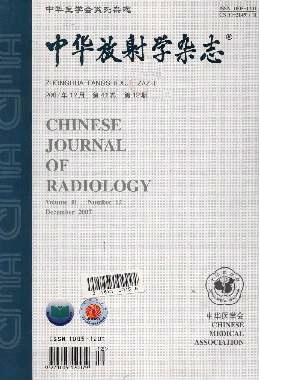The value of MR T1rho for assessing the evolution and severity of liver fibrosis in carbon tetrachloride model rats
Q4 Medicine
Zhonghua fang she xue za zhi Chinese journal of radiology
Pub Date : 2020-03-10
DOI:10.3760/CMA.J.ISSN.1005-1201.2020.03.013
引用次数: 0
Abstract
Objective To investigate the changes of liver spin-lattice relaxation time (T1rho) values in the rotating frame in the progression and regression of carbon tetrachloride (CCl4)-induced model rats with liver fibrosis and the diagnostic values for staging liver fibrosis. Methods Eighty rats were prospectively enrolled and randomly divided into the CCl4 group (n=49), the regression group (n=20) and the control group (n=11). All rats were labeled and then examined using MRI at baseline. The liver fibrosis model was established by subcutaneous injection of 40% CCl4 in hackles. The CCl4 group underwent black-blood T1rho imaging at the end of the 4th, 6th, 8th, 10th, 12th week post CCl4 injection. The regression group underwent black-blood T1rho imaging at the end of the 4th, 6th week post CCl4 injection and the end of 1st, 2nd, 4th, 6th week post CCl4 withdrawal (the injection was stopped at the end of the 6th week). The control group was injected with the same amount of corn oil at the same time point and underwent black-blood T1rho imaging at the end of 4th, 6th, 8th, 10th, 12th week. The liver T1rho values were measured in each group over time. Independent-samples t test was used to analyze the differences of liver T1rho values in adjacent time points. The experimental mice were divided into no liver fibrosis group (S0), mild liver fibrosis group (S1, 2) and moderate or severe liver fibrosis group (S3, 4). The differences of liver T1rho values were analyzed in different fibrosis stages by Kruskal-Wallis H test. The receiver operating characteristic (ROC) curve analysis was used to evaluate the diagnostic ability of T1rho values in staging liver fibrosis. The correlation between liver T1rho values and fibrosis stages was analyzed using Spearman correlation coefficient. Results Fifty-nine rats completed the whole experiment, including 28 rats in the CCl4 group, 20 rats in the recovery group and 11 rats in the control group. In the CCl4 group, the liver T1rho values gradually increased, reached the maximum at the end of week 8, and then gradually decreased. There was statistically significance in liver T1rho values at the adjacent time points (P 0.05) in control group. The T1rho values in the no liver fibrosis group (S0, n=15), the mild liver fibrosis group (S1, 2, n=23) and the moderate or severe liver fibrosis group (S3, 4, n=21) were [36.3(34.4,41.4)], (47.2±8.4), (48.8±9.0) ms, respectively. The liver T1rho values increased with the aggravation of the liver fibrosis, and there was a low positive correlation between them (r=0.402, P=0.001). There were statistically significant differences in T1rho values among the three groups (P<0.01).The area under the curve values to distinguish no liver fibrosis (S0) from liver fibrosis (S1 to 4) and no or mild liver fibrosis (S0 to 2) from moderately or severe liver fibrosis (S3,4) were 0.825 (95% confidence intervals is 0.720 to 0.931) and 0.668 (95% confidence intervals is 0.540 to 0.796), separately. Conclusion The liver T1rho values are useful for evaluating the progression and regression of liver fibrosis. It has a moderate diagnostic value to assess the presence of liver fibrosis, but a low diagnostic value to differentiate no or mild liver fibrosis from moderately to severe liver fibrosis. Key words: Liver fibrosis; Rat; Carbon tetrachloride; Magnetic resonance imagingMR T1rho在评估四氯化碳模型大鼠肝纤维化演变和严重程度中的价值
目的探讨四氯化碳(CCl4)诱导的肝纤维化模型大鼠肝旋转架中肝脏自旋晶格弛豫时间(T1rho)值在进展和消退过程中的变化及其对肝纤维化分期的诊断价值。方法80只大鼠前瞻性入选,随机分为CCl4组(n=49)、回归组(n=20)和对照组(n=11)。对所有大鼠进行标记,然后在基线时使用MRI进行检查。用40%四氯化碳皮下注射建立大鼠肝纤维化模型。CCl4组在注射CCl4后第4、6、8、10、12周末进行了全血T1rho成像。回归组在注射CCl4后第4周、第6周结束时以及停药后第1周、第2周、第4周和第6周(第6周停止注射)结束时接受了全血T1rho成像。对照组在同一时间点注射相同量的玉米油,并在第4、6、8、10、12周末进行全血T1rho成像。测量各组随时间变化的肝脏T1rho值。采用独立样本t检验分析相邻时间点肝脏T1rho值的差异。实验小鼠分为无肝纤维化组(S0)、轻度肝纤维化组、中度或重度肝纤维化组。通过Kruskal-Wallis H检验分析不同纤维化阶段肝脏T1rho值的差异。受试者工作特性(ROC)曲线分析用于评估T1rho值在肝纤维化分期中的诊断能力。使用Spearman相关系数分析肝脏T1rho值与纤维化分期之间的相关性。结果59只大鼠完成了整个实验,其中CCl4组28只,恢复组20只,对照组11只。在CCl4组中,肝脏T1rho值逐渐增加,在第8周末达到最大值,然后逐渐降低。对照组各时间点肝脏T1rho值有统计学意义(P<0.05)。无肝纤维化组(S0,n=15)、轻度肝纤维化组的T1rho值(S1,2,n=23)和中度或重度肝纤维化组中(S3,4,n=21)分别为[36.3(34.4,41.4)]、(47.2±8.4)和(48.8±9.0)ms。肝脏T1rho值随着肝纤维化的加重而增加,三组间T1rho值差异有统计学意义(P<0.01)。区分无肝纤维化(S0)与肝纤维化(S1~4)、无或轻度肝纤维化(SO~2)与中度或重度肝纤维化(S3,4)的曲线下面积分别为0.825(95%置信区间为0.720至0.931)和0.668(95%置信间隔为0.540至0.796)。结论肝脏T1rho值可用于评估肝纤维化的进展和消退。评估肝纤维化的存在具有中等诊断价值,但区分无肝纤维化或轻度肝纤维化与中度至重度肝纤维化的诊断价值较低。关键词:肝纤维化;大鼠;四氯化碳;磁共振成像
本文章由计算机程序翻译,如有差异,请以英文原文为准。
求助全文
约1分钟内获得全文
求助全文
来源期刊

Zhonghua fang she xue za zhi Chinese journal of radiology
Medicine-Radiology, Nuclear Medicine and Imaging
CiteScore
0.30
自引率
0.00%
发文量
10639
 求助内容:
求助内容: 应助结果提醒方式:
应助结果提醒方式:


